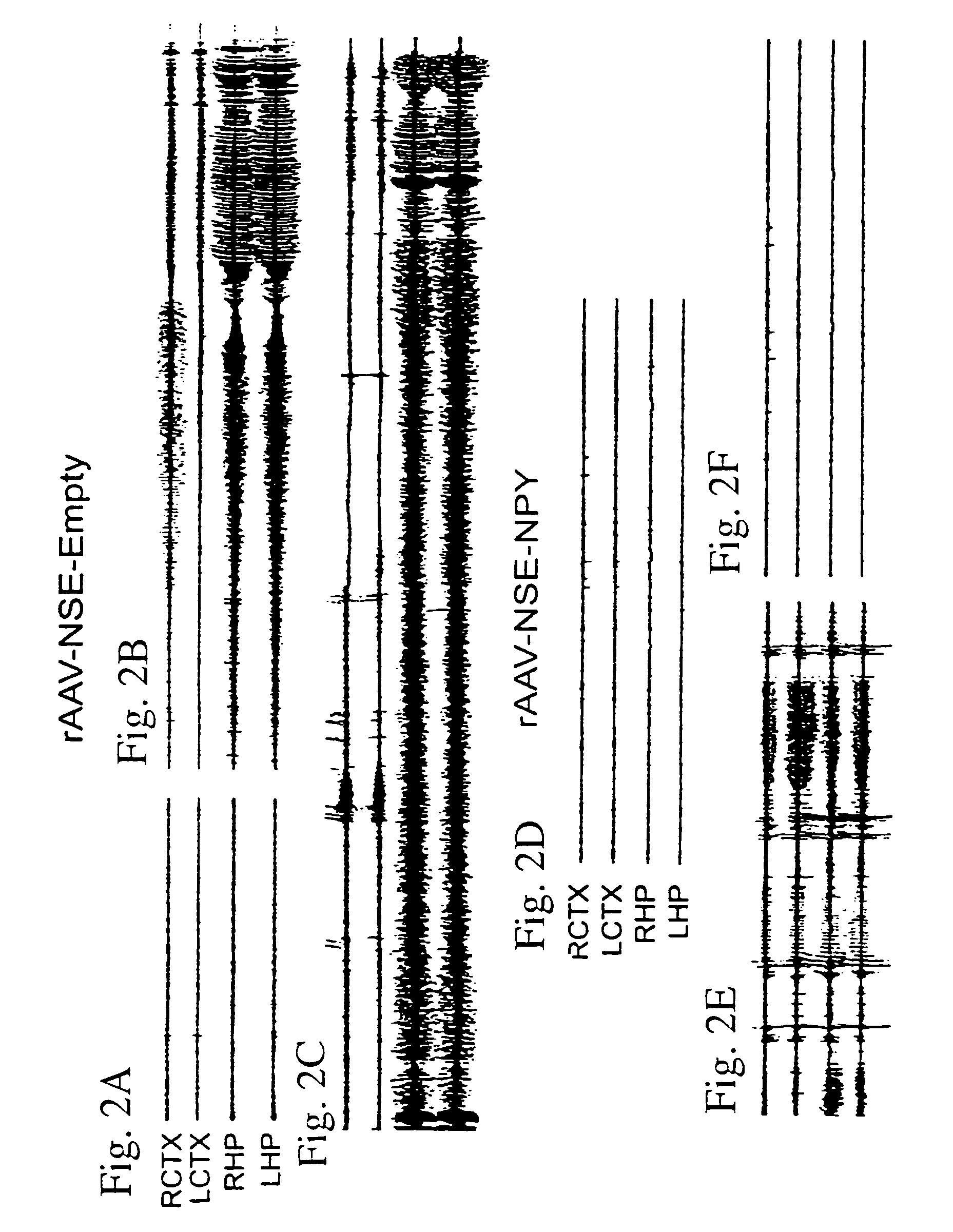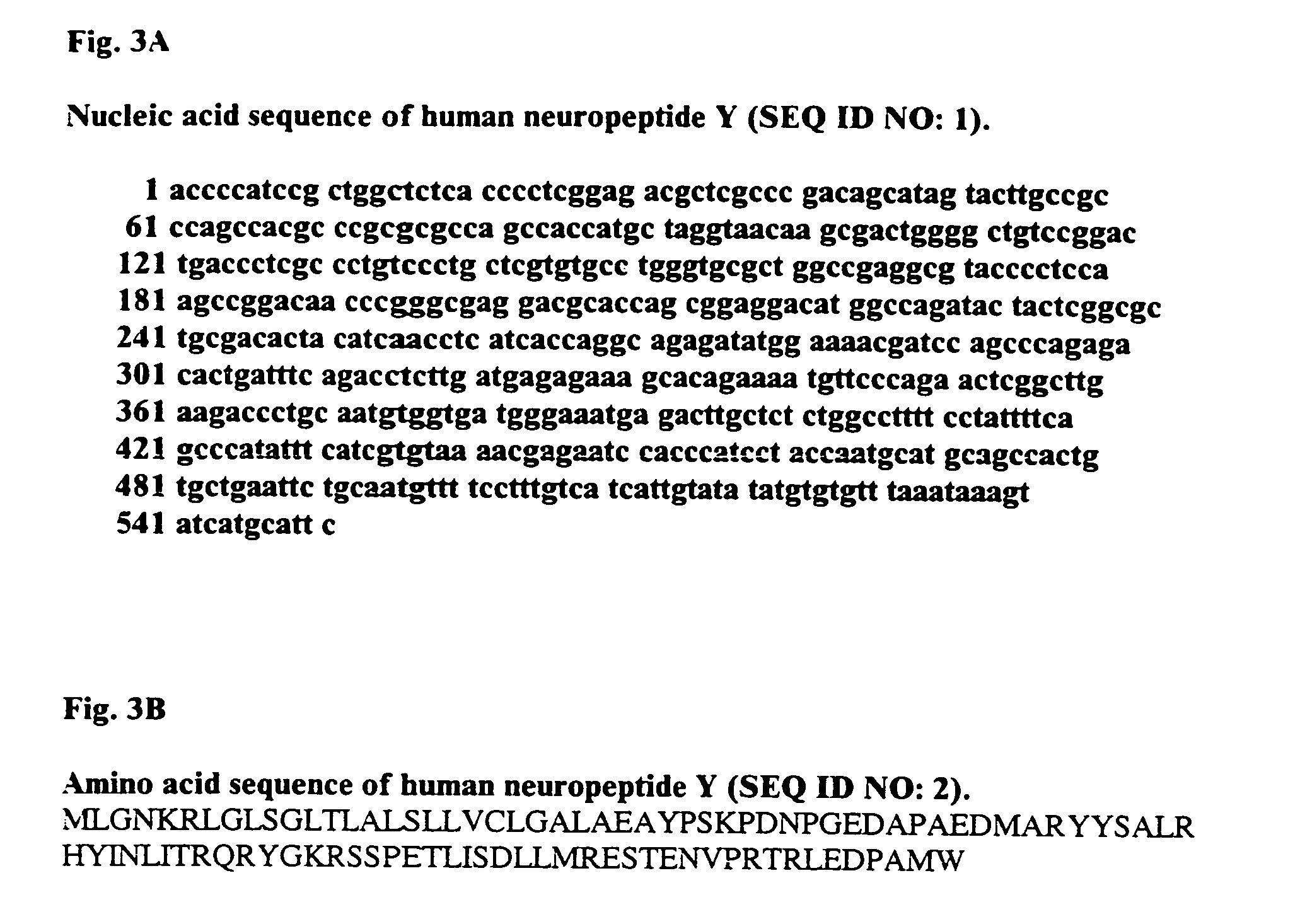Methods and compositions for the treatment of neurological disease
a neurological disease and composition technology, applied in the field of neurological disease treatment methods and compositions, can solve the problems of neurological diseases, profound challenges for patients, care givers, attending physicians, etc., and achieve the effects of reducing the frequency, severity and/or duration of epileptic seizures, reducing the symptoms of neurological diseases, and reducing the frequency of neurological diseases
- Summary
- Abstract
- Description
- Claims
- Application Information
AI Technical Summary
Benefits of technology
Problems solved by technology
Method used
Image
Examples
example i
[0167]The results presented herein reveal that long-lasting overexpression of NPY following gene transfer mediated by a recombinant adeno-associated viral (AAV) vector dramatically reduces acute kainate seizures and kindling epileptogenesis in a rat model system of human epilepsy. Notably, transgene expression was significantly increased by 7 days and persisted for at least 3 months. Serotype 2 AAV vector increased NPY expression in hilar interneurons, whereas the chimeric serotype 1 / 2 vector resulted in more widespread expression that also encompassed mossy fibers, pyramidal cells, and the subiculum. EEG seizures induced by intrahippocampal kainate were reduced by 50% to 75% depending on the spread of NPY expression, and seizure onset was markedly delayed. Moreover, in rats injected with chimeric serotype 1 / 2 vector, status epilepticus was abolished and kindling acquisition was significantly delayed. Thus, targeted NPY gene transfer offers a novel strategy for effective anti-epilep...
example ii
[0196]The present inventors have extended and corroborated the results presented in Example I by demonstrating that NPY is released from brain slices taken from animals that were previously injected with AAV-NPY. The data presented in Table 3 and FIG. 7 were generated using brain slices isolated from rats injected with the chimeric vector 1 / 2 AAV-NPY vector described herein above. As shown in Table 3 and FIG. 7, NPY release from these brain slices is triggered in a potassium-dependent manner, which recapitulates the physiological conditions that stimulate release of endogenous NPY. Release of endogenous NPY from brain slices taken from control animals (previously injected with AAV control vector) is not detectable using the present methods. These results demonstrate that ectopic or exogenous NPY is expressed at higher levels than endogenous NPY when induced in a potassium-dependent manner.
[0197]The release data shown in Table 3 and FIG. 7 were generated using methodology described p...
example iii
[0200]The present inventors have also made the surprising discovery that in animals wherein gene transfer of NPY is achieved using an AAV vector, Y2 subtype NPY receptors are not downregulated, whereas NPY Y1 subtype receptors are down-regulated. See FIGS. 8A-D. This finding is important in the context of the present invention because the Y2 subtype receptors are inhibitory and, in large part, mediate the anti-epileptic and inhibitory effects of NPY. Moreover, the decrease in Y1 subtype NPY receptors is beneficial in the method of the present invention because these receptors mediate excitatory effects of NPY. See Gariboldi et al. [Eur J. Neurosci. 1998, 10(2):757-9 and Benmaamar et al. [Eur J Neurosci. 2003, 18(4):768-74]. In that chronic administration of many growth factors and other proteins is associated with downregulation of their receptors and signal transduction pathways linked to their receptors, the results shown for the NPY Y2 subtype receptor are surprising and lend add...
PUM
| Property | Measurement | Unit |
|---|---|---|
| constant temperature | aaaaa | aaaaa |
| pH | aaaaa | aaaaa |
| nucleic acid sequence | aaaaa | aaaaa |
Abstract
Description
Claims
Application Information
 Login to View More
Login to View More - R&D
- Intellectual Property
- Life Sciences
- Materials
- Tech Scout
- Unparalleled Data Quality
- Higher Quality Content
- 60% Fewer Hallucinations
Browse by: Latest US Patents, China's latest patents, Technical Efficacy Thesaurus, Application Domain, Technology Topic, Popular Technical Reports.
© 2025 PatSnap. All rights reserved.Legal|Privacy policy|Modern Slavery Act Transparency Statement|Sitemap|About US| Contact US: help@patsnap.com



